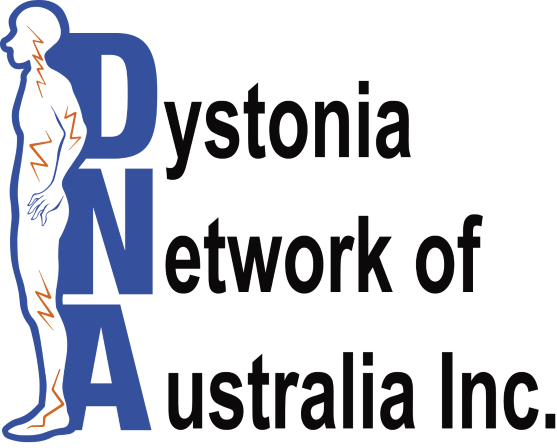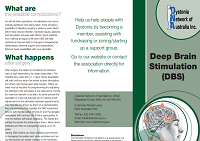What is Deep Brain Stimulation (DBS)?
DBS is a neurosurgical procedure used successfully for people with dystonia for around fifteen years. It is not a cure but a valid treatment option. Initially a surgical treatment for Parkinson’s disease, it is now used for many different neurological and psychiatric conditions. In DBS for dystonia, electrodes are implanted deep in the brain in an area of the basal ganglia called the globes pallidus internal (GPi), although different target areas in the basal ganglia and in the thalamus are being trialled. The electrodes are attached to extension cables passed under the skin of the scalp and neck to a battery/stimulator usually placed in the chest wall under the skin. It is similar o a cardiac pacemaker.
The stimulator is initially programmed by the neurologist or neurosurgeon with the assistance of a specialist nurse in some centres. It controls the abnormal movements of dystonia but its action is not completely understood. It is thought that the electrical stimulation interrupts or blocks the abnormal signals coming from the brain that cause the muscle spasms responsible for the abnormal positions and movements.
What preparation is required?
Assessment by a specialist neurologist is required and advice given on whether you may be a candidate for DBS. If you are considered a candidate, the specialist will then refer you to a neurosurgeon to discuss the benefits and complications of the procedure. Other health professionals may be required such as a clinical psychologist for emotional health support, a clinical neuropsychologist for cognitive testing, or a speech pathologist as voice can be affected. Genetic testing has a limited role but may assist in estimating responsiveness to DBS. It is important to understand that not all dystopias will respond to DBS.
Who is a candidate for DBS?
Deep Brain Stimulation has been used successfully in some dystonia, including young-onset generalised dystonia and severe neck dystonia. If botulinum toxin is considered beneficial this will often be trialled prior to referral for DBS. If the specialist considers that your type of dystonia would respond to DBS and you are able to consent to the procedure, then your neurologist and neurosurgeon will discuss fully the likely outcome and the possible risks. It will then be up to you, in consultation with your family, to decide if this is the correct choice for you.
How is the surgery performed?
The surgery may be performed with the patient awake (local anaesthesia) or asleep (general anaesthesia). This depends on the type of abnormal movements caused by the dystonia, the patient’s age and the preferences of both the patient and the neurosurgeon. Magnetic Resonance Imaging is used to target the preferred area of the brain for placement of the electrodes. A metal frame will be placed on your head and you will be transferred for a scan (CT or MRI) which is used to guide the neurosurgeon in placing the leads. The frame also assists in keeping your head still during surgery. Guided by very sophisticated computer programmes and equipment, the electrodes are implanted deep in the brain, in the area of choice. The target is identified by the neurologist and neurosurgeon who interpret the type of electrical signals they receive from the electrodes as they are positioning them.
When the neurologist and the neurosurgeon are confident the electrodes are in position this part of the operation is completed. For the second part of the surgery the extension cables are passed under the skin and connected to the stimulator usually placed just below the collarbone. The patient is under general anaesthetic for this part of the surgery. Although it is more common for the leads to be attached to the stimulator on the same day, some centres place the leads in a second operation some days after the DBS surgery.
What are the possible benefits?
DBS can improve your quality of life by assisting in the control of the symptoms of dystonia such as reducing pain, muscle spasm and the abnormal positions or postures of the parts of the body affected. The full effect of DBS is not necessarily immediate but can take some months to develop. DBS is usually reversible and adjustable unlike previous dystonia surgery involving lesions (pallidotomy, thalamotomy). It should be noted that DBS is not successful for everyone and degrees of success can vary. Many patients are able to stop other treatments for their dystonia but some still continue to receive treatments including botulinum toxin and oral medication.
What are the possible complications?
As with all brain operations, complications can occur. Despite significant care being taken, there remains a possibility of bleeding causing a stroke or even death. Other risks include infection, hardware issues, seizures and stimulation induced side effects. Some patients find it difficult to adjust to life after DBS with less dystonia as this can lead to changes in interpersonal relationships, external support and expectations. Discuss these possibilities with your specialist.
What happens after surgery?
After surgery the patient is transferred to intensive care or high dependency for close observation. The hospital stay varies from 2 to 7 days. Some specialists will wait until you return for review to start stimulating but others commence soon after surgery. Follow up visits may be required for programming and adjusting the settings of the stimulator. It can take some months for maximum benefit to be seen. At some centres the specialist or nurse will educate you in making small adjustments to the stimulator between appointments. You may also be shown by them or a representative from the company that supplies the DBS equipment how to turn the stimulator off and on and the dangers associated with turning it off, if this is appropriate. In time the battery will require replacing. The higher the setting the sooner the battery runs down. More recent batteries are often re-chargeable, lasting up to 25 years.
Having DBS means you have a lifelong commitment to managing the system and some activities such as contact sports can cause damage to the hardware.
Page reviewed 31 January 2024





